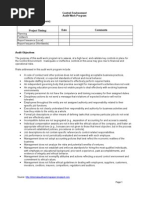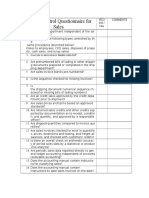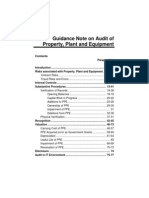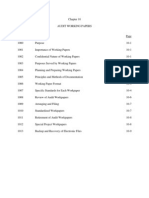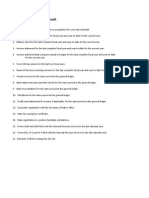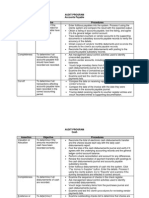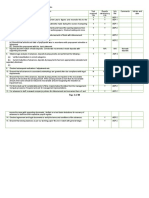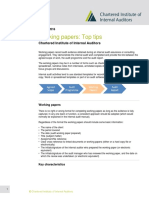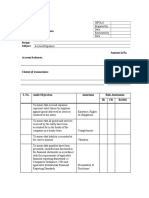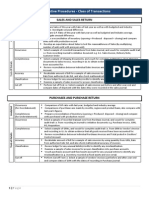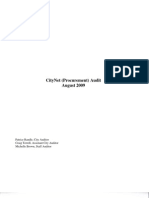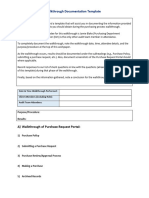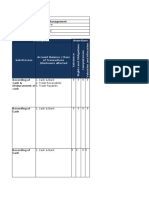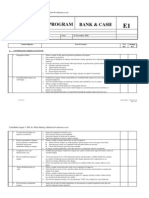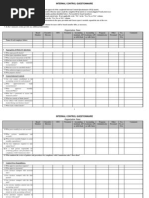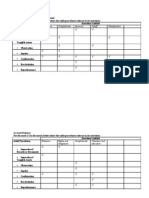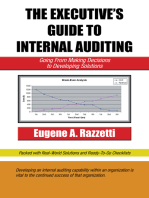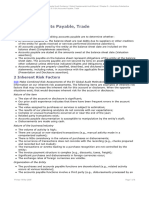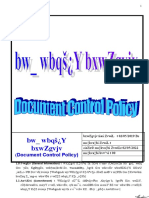Inventory Audit Work Program
Inventory Audit Work Program
Uploaded by
Adnan MohammedCopyright:
Available Formats
Inventory Audit Work Program
Inventory Audit Work Program
Uploaded by
Adnan MohammedCopyright
Available Formats
Share this document
Did you find this document useful?
Is this content inappropriate?
Copyright:
Available Formats
Inventory Audit Work Program
Inventory Audit Work Program
Uploaded by
Adnan MohammedCopyright:
Available Formats
INVENTORY AUDIT WORK PROGRAM
Project Team (List Members):
Project Phase Date Comments
Planning
Fieldwork
Report Issuance
Time Project Work Step Initial Index
PRE-AUDIT
1. Review prior audit report and relevant press releases
NA
(acquisitions).
2. Obtain completed inventory internal control
questionnaire from the plant controller. Document
NA
any potential control weaknesses or unusual
practices and investigate upon arrival.
3. Obtain and document the following as of the audit
date:
a) Trial Balance
NA
b) Manufacturing Statement (YTD)
NA
c) Manufacturing Budget (YTD)
Verify
d) Date of Last Physical
NA
e) Cycle Counting Accuracy History
Verify
f) Inventory Turnover, Days Sales in
Inventory, Margin
Verify
g) Date and Scope of External Auditor's Most
Recent Visit
Verify
h) Detail of Excess and Obsolete Inventory
NA
i) Detail of Inventory Held on Consignment
Verify
j) Detail of Inventory Held at Subcontractor
and Outside Vendor
NA
k) Type of Inventory System
l) Size of Facility (Square Footage)
m) Primary products
Verify
n) Top Five Customers and Competitors
4. Ensure financial statement trial balance agrees with Verify with
the trial balance maintained by the facility. Obtain WH Keeper
explanations for any differences with the plant &
controller upon arrival. Accounting
5. Obtain and quantify in ACL the following reports as of
the audit date:
a) Inventory Aging Report Verify
b) Perpetual Inventory Listing Verify
c) All Open Work Orders NA
October 1, 2023 Internal Audit Activity Page 1 of 19
Time Project Work Step Initial Index
6. Reconcile perpetual inventory listing with the account
balances that appear on the G/L. Obtain and Verify with
document explanations for differences from the Accounting
controller upon arrival.
Verify if
there are
7. Obtain and document explanations from the
old/back
controller for all open work orders older than two
orders &
months.
duration of
each one
8. Describe procedures for developing current year
material, labor and overhead standards, and the date
of the last revision. If a standard system is not used,
NA
obtain and document an explanation from the
controller and/or corporate operations as to why a
standard system has not been implemented.
Verify if
9. Compare and document budgeted variances to
there is
actual variances for materials, labor and overhead.
comparison
Obtain and document explanations for significant (5%
of variances
+) variances from the controller and/or corporate
of stock to
operations.
budgeted
10. For facilities that do not employ a standard costing
system, recalculate labor and overhead allocations
and compare to the amount capitalized. Obtain and NA
document explanations for significant (10%+)
variances from the controller upon arrival.
11. Discuss conclusions/observations with the senior
associate. Obtain and document T&B senior
management concerns and ensure there are NA
adequate procedures in the program to address those
risks.
October 1, 2023 Internal Audit Activity Page 2 of 19
Time Project Work Step Initial Index
RECEIVING
1. Interview employees associated with the receiving
process in order to gain an understanding. Map this
process and include all applicable financial journal
entries.
2. Through inquiry and observation, ensure the
following controls are in place and operating
effectively and are included on the process map.
Identify all control gaps.
a) Goods are received at a designated
receiving bay
b) Receipts are checked for quantity and
quality
c) All goods received are based on a valid
purchase order (PO) number
d) PO is stated on delivery documents and is
verified for validity
e) The quantity of goods received is verified to
the packing slip and bill of lading
f) The receiver signs delivery documents
g) All receipts are recorded in a log and can
be cross referenced to the appropriate delivery
documents
h) The log is regularly reviewed
i) Receipts are accurately, promptly and
completely updated in the inventory system
j) Goods are safeguarded
k) Transfer of goods are documented
l) Items not meeting qualifications are kept
separate from other items
3. Process map procedures for vendor returns.
Through inquiry and observation, ensure that returns
are communicated to the purchasing department and
October 1, 2023 Internal Audit Activity Page 3 of 19
Time Project Work Step Initial Index
debit memos are prepared and forwarded to
accounts payable in a timely manner. In most
instances, this will require sampling returns during
the audit period.
4. Through inquiry and observation, ensure that
shipment discrepancy reports are pre-numbered and
reviewed by the appropriate purchasing and
accounting personnel to ensure that debit memos
have been taken.
PRODUCTION PROCESS/PHYSICAL SECURITY
1. Interview employees associated with the
production process. Map the production process and
include all applicable financial journal entries. Ensure
the following controls are present and are included in
the process map. Identify all control gaps.
a) Authorized persons approve goods
requisitions
b) goods requisitions coincide with the
approved sales plan
c) Disbursements from stockrooms are
allowed only upon receipt of properly authorized
requisition documents
d) Management approval is required for stock
issuance of amounts above the amount
necessary to support scheduled sales
requirements
e) Approved requisition documents and
inventory movement forms are promptly used to
update the inventory records
f) Pre-numbered requisition forms or
sequential logs are used to record issuance of
materials from stores and inventory movement
between locations
g) Warehouse/store is properly locked to
prevent unauthorized access and usage
h) Proper segregation of scrap and obsolete
inventory
October 1, 2023 Internal Audit Activity Page 4 of 19
Time Project Work Step Initial Index
PHYSICAL COUNTS
1. Obtain and review information supporting the most
recent wall-to-wall physical inventory. Ensure
quantities on hand were not known to counters prior
to the physical. Document compliance with corporate
policy.
2. Complete the physical inventory checklist.
Document control gaps, if any.
3. Document book-to-physical adjustments for the
past three years. Inquire as to whether or not the
adjustments were investigated prior to correcting
entries being made. Document your understanding of
this process. Determine when and if the adjustments
were capitalized or expensed and if they were
approved.
4. Evaluate propriety of reconciling items between the
perpetual inventory listings and the G/L account
balances. Examine supporting documentation for
each item individually greater than 2.5% of the
inventory account balance (or 50% of the items if
none individually exceed 2.5%, but the aggregate
exceeds 5%.)
5. Obtain, review and document policies and
procedures surrounding cycle counts. Observe two
cycle counts and document the following:
a) What was counted and how it was selected
b) Cycle counter is not aware of quantity on
hand prior to his count
c) Agree test counts to perpetual inventory
detail
d) Examine adjustment to perpetual inventory
detail/general ledger, if applicable
e) Document historical accuracy rates
6. Based solely on the work performed, document
observations regarding the physical security of
inventory.
7. Based on the date and results of the most recent wall-
to-wall physical count and the applicability of cycle
counts, consider performing the following:
a) Agree 10 inventory items per the perpetual
to the quantity on hand
October 1, 2023 Internal Audit Activity Page 5 of 19
Time Project Work Step Initial Index
b) Agree 10 inventory items on hand to the
perpetual
INVENTORY VALUATION
For facilities using a standard costing system, perform the
following:
1. Document procedures for developing current year
standards (raw material, labor and overhead) and the
date of the most recent development. Document
compliance with corporate policy.
2. On a sample basis (minimum of 30), test the
accuracy of the standards by performing the
following:
a) Examine recent invoices supporting raw
material component
b) Examine payroll-related information
supporting labor component, if applicable
c) Examine overhead estimate. Recalculate
based on available information
3. On a sample basis, examine the method and
accuracy of recording standard to actual variances.
Obtain explanations for standard to actual variances
greater than the budgeted amount as of audit date.
Examine entries to record variances and document
whether the variances were capitalized or expensed.
For facilities not using a standard costing system,
perform the following:
1. Document procedures for developing current year
labor and overhead amounts.
2. Examine (minimum of 30) recent invoices
supporting raw materials, and the raw material
component of WIP and FG. Document results by
quantifying unit cost variances and extrapolating to
population.
3. Recalculate labor and overhead calculations and
compare to amounts capitalized. Document
limitations in ability to recalculate.
October 1, 2023 Internal Audit Activity Page 6 of 19
Time Project Work Step Initial Index
INVENTORY RESERVES
1. Based on ACL reports, document inventory greater
than 180, 270 and 360 days.
2. Document method for estimating reserve for excess
and obsolete inventory. Document compliance with
corporate policy.
3. Obtain calculation of E&O estimate for most recent
quarter-end and agree to G/L. Agree significant
components to supporting documentation.
4. Document inconsistencies, if any, between the
calculation and aging analysis.
5. Ensure authorized persons adequately approve
provisions or write-offs. Review for evidence of
approval of inventory write-offs before they are
recorded.
October 1, 2023 Internal Audit Activity Page 7 of 19
Time Project Work Step Initial Index
CONSIGNMENT INVENTORY
1. Document policies and procedures for consigned
inventory. At a minimum, address the following items:
a) Existence of perpetual detail
b) Method of reporting, recording and verifying
changes
c) Method of accounting for scrap
d) Results of recent physical counts
2. Document compliance with corporate policy on
consigned inventories.
October 1, 2023 Internal Audit Activity Page 8 of 19
Time Project Work Step Initial Index
SCRAP
1. Document method for accounting for inventory scrap.
At a minimum, address the following:
a) Method used to quantify
b) Method used to cost
c) Method used to dispose
2. Through inquiry and observation, ensure that scrap
proceeds are collected from the scrap vendor
promptly after the collection of scrap materials.
3. Through inquiry and observation, ensure that approval
is granted before materials are sent to scrap.
4. Through inquiry and observation, ensure that
accounting and the warehouse verify the weight of
the scrap materials.
5. Through inquiry and observation, verify that scrap
vendors are selected through a bidding process.
October 1, 2023 Internal Audit Activity Page 9 of 19
Time Project Work Step Initial Index
SHIPPING AND RECEIVING (INCLUDING RETURNS)
1. For the most recent quarter-end, obtain the last and
first three shippers and receivers and agree pertinent
data to accounts receivable and inventory records
ensuring that transactions are recorded in the proper
period.
2. Explain the facility’s procedures for ensuring proper
cut-off.
October 1, 2023 Internal Audit Activity Page 10 of 19
Time Project Work Step Initial Index
GENERAL
1. Through inquiry and observation confirm that
management corrective action plans have been
implemented. If not, obtain explanation(s) and
consider the necessity of including in current year
audit report.
2. Complete best practices checklist.
3. Complete inventory diagnostic.
4.
5.
6.
October 1, 2023 Internal Audit Activity Page 11 of 19
INVENTORYAUDIT WORK PROGRAM: SAMPLE 2
Project Team (List Members):
Project Timing Date Comments
Planning
Fieldwork
Report Issuance (Local)
Report Issuance (Worldwide)
Objectives
Evaluate controls in place over inventory functions, such as cycle counting, customer
returns, physical security, shipping and receiving.
Evaluate overall efficiency of the inventory management process.
Provide management team with cost effective suggestions to improve the general control
environment as well as to increase operating efficiency.
Time Project Work Step Initial Index
1. Review existing policies and procedures for the
inventory management functions, including: cycle
count procedures, handling of returned materials, the
scrap process, shipping and receiving, physical
security, training, and handling of slow moving,
excess and obsolete inventory.
2. Interview to understand the process.
Obtain an understanding of the overall inventory
management processes by interviewing key
personnel.
Perform an initial flowcharting of the process as
described by the personnel involved and
interviewed. Update the flowchart periodically as the
audit work progresses and the internal audit team’s
understanding grows.
Ensure that the finalized process flow diagram is
included in the audit report. This diagram should
include, at a minimum a.) Each major process step,
such as shipments arrive, shipments are counted,
quality control steps, bin report is generated, etc. b.)
Which departments are involved in the step, such
as inventory control, technology support,
purchasing, etc. c.) Reports being used/reviewed
October 1, 2023 Internal Audit Activity Page 12 of 19
Time Project Work Step Initial Index
d.) Manual internal control points e.) System-based
control points and f.) Internal control weaknesses.
3. Test for the following inventory process control points
and/or understand what alternative control(s) the
company has in place.
Blind (counter does not know system inventory
figure) cycle counts
Cycle count reconciliation
Write-off authorization
Shipment forms created outside of the warehouse
Exception reports reviewed daily
Receiving dept. counts all items received
Quality control (QC) inspection on all items received
Goods recounted after QC inspection
All goods have movement tracking sheets
Carriers sign manifest documents
4. Test for the following inventory physical control points
and/or understand what alternative control(s) the
company has in place.
Badge access is required
A security officer is in place in the warehouse and
the officer moves selected goods
A list of all personnel with access to the warehouse
is reviewed on a periodic basis to determine
whether these people should remain. The list is
adjusted as necessary.
Video cameras in the warehouse and security tapes
are reviewed on a scheduled basis
There are set receiving hours
October 1, 2023 Internal Audit Activity Page 13 of 19
Time Project Work Step Initial Index
There are locked cages for selected goods
5. Test for the following inventory system control points
and/or understand what alternative control(s) the
company has in place.
Bins/inventory accounts “blocked” during cycle
counts
Picking documents are created by system, not
manual
Shipping/receiving documents are scanned
Test system procedures for maintaining the
completeness of all information initially captured at
time of product receipt
Test reconciliation procedures to ensure
completeness/accuracy of the process as
product/materials receipts move from one location
to another
6. Ensure that scrap material is identified, tracked and
destroyed in a secure and controlled manner. All
destruction of scrap material should be witnessed.
7. Ensure that weekend and holiday access to the
warehouse is granted on an exception basis only, as
approved by the warehouse manager.
8. Ensure that a cross-training program exists for all
warehouse personnel. This should include, at a
minimum, re-training on any new policies and
procedures that result from the internal audit review.
9. Ensure that slow moving and obsolete inventory
reports are reviewed monthly. Consider the need for a
unique location to monitor slow moving and obsolete
items.
10. Ensure that a well-controlled management approval
process is in place to authorize any adjustment to
inventory balances in the system. The larger the
adjustment, the higher level the authorizing manager
should be, all the way up to the CFO.
October 1, 2023 Internal Audit Activity Page 14 of 19
Time Project Work Step Initial Index
11. Test that each shipment is counted and compared to
the packing slip prior to admission into inventory.
Discrepancies should be noted and tracked via a
discrepancy log.
12. Review management reports and also understand the
performance metrics being used to monitor the
inventory management process. Ensure that metrics
truly reflect the department’s/company’s goals.
13. In order to promote consistent practices, ensure that
the policies and procedures document is updated for
any process changes that resulted from the internal
audit review.
October 1, 2023 Internal Audit Activity Page 15 of 19
INVENTORY AUDIT WORK PROGRAM: SAMPLE 3
Project Team (List Members):
Project Phase Date Comments
Planning
Fieldwork
Report Issuance
Audit Objectives
Objective Comments Initial
1. Evaluate the processes
needed to procure, store and
manage inventories: raw
materials, work-in-progress
and finished goods.
2. Evaluate the effectiveness
and efficiency of current
inventory management
processes, which will include:
Forecasting requirements
to match marketplace
demands
Organizing the function
electronically
Ensuring accuracy of
inventories and related
recordkeeping activities
Optimizing supply base
Time Audit Step Initial Index
PLANNING & GENERAL
1. Identify key management sponsors and other
individuals who will be directly affected by the review
and send a formal notification memo approximately 2-
4 weeks prior to the beginning of fieldwork.
Communicate objectives, timing and expectations of
degree of assistance required of personnel.
2. Complete scoping and planning activities sufficient to
prepare a detailed work plan and time budget.
Complete work plan and submit for
manager/supervisory approval.
October 1, 2023 Internal Audit Activity Page 16 of 19
Time Audit Step Initial Index
3. Prepare time estimate and communicate expectations
to all team members.
4. Review and become well-acquainted with the
following:
Current procedures to monitor inventory
Organization charts
Background on current processes
5. Schedule and hold a final planning meeting prior to
the beginning of any significant fieldwork. Involve the
complete audit team. Discuss the detailed plan and all
relevant assignments, expectations, etc.
6. Set up and organize workpapers.
7. Provide manager with weekly status reports, including
summary of hours incurred, estimates to complete,
and budget versus actual status.
UNDERSTAND THE PROCESS
1. Through individual interviews or small group
meetings, develop an understanding of the key
processes and activities that relate to inventory
management. Develop process maps, if appropriate,
to document understanding of the processes and
activities.
Representation of individuals from the following
departments should be considered:
Purchasing
Warehousing
Distribution
Finance
Marketing/Support
Engineering
a. Focus attention on identifying and
documenting the key internal controls in
each area. Evaluate the type and quality
of each control.
b. Document any process performance
issues/problems that are identified.
2. Analyze current financial data relating to inventory,
including demand projections and physical/perpetual
inventory records.
3. Analyze company policies and assess compliance
with the policies for minimizing inventory levels,
reserves and write-offs.
4. Analyze methods used to calculate production and
inventory costs. Benchmark costing methods with any
October 1, 2023 Internal Audit Activity Page 17 of 19
Time Audit Step Initial Index
known best practices.
IDENTIFY PROCESS PERFORMANCE GAPS
1. Summarize and gauge the significant process
improvement opportunities identified.
2. Determine relevant key process measures and
controls to target for validation.
3. Discuss observations with management.
4. Test accuracy and reliability of relevant performance
measures and management information.
VALIDATE PROCESS MEASURES & CONTROLS
1. Test compliance with current policies and procedures.
2. Test accuracy and reliability of relevant performance
measures and management information.
ANALYZE ROOT CAUSES OF PROCESS
OPERATING AND CONTROL DEFICIENCIES
1. As required to develop specific action steps to
improve processes and controls, complete additional
analysis on specific issues. (Consult with
senior/manager for scope of issues and additional
analysis required.)
2. Define and refine solutions/recommendations for key
findings and issues. Draft formal written findings and
recommendations. Each finding should include: (1)
What should be, (2) what is, (3) why a difference
exists between (1) & (2), (4) business impact of
difference, and (5) recommended course of action to
correct deficiency.
3. Validate each finding, recommendation and course of
action with process owner or other appropriate
management.
REPORTING AND WRAP-UP
1. Draft final reports for manager review and approval.
2. Draft report should include the following sections:
Executive Summary
Objectives & Scope Statement
Background (in general and for each process)
Summary of Procedures Performed
Detailed Findings & Recommendations
(organized by area/process/significance)
Action Matrix
Follow-Up Procedures
Appendix: Process Maps
3. Review draft report in closing meeting with all
process owners. All findings and recommendations
should have been discussed prior to the closing
October 1, 2023 Internal Audit Activity Page 18 of 19
Time Audit Step Initial Index
meeting so that this meeting is only a formality.
4. Clear draft report with corporate controller and/or
other appropriate personnel.
5. Make final revisions and issue final report.
6. Distribute customer satisfaction survey forms.
7. Finalize working paper documentation related to all
work performed.
8. Prepare final time summary and staff evaluation
forms.
October 1, 2023 Internal Audit Activity Page 19 of 19
You might also like
- Payroll Internal Audit ProgramDocument2 pagesPayroll Internal Audit ProgramEric Gunthe100% (9)
- Physical Inventory Observation ChecklistDocument10 pagesPhysical Inventory Observation Checklistফয়সাল হোসেন50% (2)
- Business Plan On Event Management 1Document31 pagesBusiness Plan On Event Management 1Danish Ali100% (1)
- Audit Planning MemoDocument10 pagesAudit Planning MemoChyrra ALed ZuRc100% (4)
- Internal Audit ProgramDocument8 pagesInternal Audit ProgramKrishna Khandelwal100% (5)
- Final Accounts Payable Audit ProgramDocument5 pagesFinal Accounts Payable Audit Programjeff100% (3)
- Control Environment Audit Work ProgramDocument6 pagesControl Environment Audit Work ProgramLawrence MaretlwaNo ratings yet
- Sales and Promotion of Tvs Motor CompanyDocument46 pagesSales and Promotion of Tvs Motor Companyankita merchant88% (8)
- Milky Mist Risk & Control Matrix - Procure To Pay: COSO Principle Process Name Control Activity No. Coso ComponentDocument20 pagesMilky Mist Risk & Control Matrix - Procure To Pay: COSO Principle Process Name Control Activity No. Coso ComponentAswath S100% (1)
- Audit ProgrammesDocument63 pagesAudit ProgrammesSarah Hashem100% (1)
- Accruals Audit ProgramDocument4 pagesAccruals Audit Programvivek1119No ratings yet
- Internal Control Questionnaire For SalesDocument1 pageInternal Control Questionnaire For SalesJustine Ann VillegasNo ratings yet
- Illustrative Work-Paper Template For Testing ROMM and Performing WalkthroughsDocument35 pagesIllustrative Work-Paper Template For Testing ROMM and Performing Walkthroughsdroidant100% (1)
- Audit Programe - InventoryDocument3 pagesAudit Programe - InventoryAnnete Utomo Hutabarat100% (1)
- Auditing Fixed Assets and Capital Work in ProgressDocument23 pagesAuditing Fixed Assets and Capital Work in ProgressMM_AKSI87% (15)
- 10chap Audit Working PapersDocument10 pages10chap Audit Working PapersZahar Zahur Kaur Bhullar100% (1)
- ABC Company Audit Program - Receivables Department:: 1) Analytical Procedures-GeneralDocument7 pagesABC Company Audit Program - Receivables Department:: 1) Analytical Procedures-Generalvarghese200779% (14)
- The Operational Auditing Handbook: Auditing Business and IT ProcessesFrom EverandThe Operational Auditing Handbook: Auditing Business and IT ProcessesRating: 4.5 out of 5 stars4.5/5 (5)
- AU Locks Auditing Services: Audit Program Batangas Bestfeeds Multipurpose CooperativeDocument5 pagesAU Locks Auditing Services: Audit Program Batangas Bestfeeds Multipurpose CooperativeMirai KuriyamaNo ratings yet
- 02 Revenue Receipts Cycle Controls and Tests of ControlsDocument31 pages02 Revenue Receipts Cycle Controls and Tests of ControlsRonnelson PascualNo ratings yet
- Audit WorksheetDocument7 pagesAudit WorksheetEricXiaojinWangNo ratings yet
- Auditing Income Statement and Balance Sheet ItemsDocument27 pagesAuditing Income Statement and Balance Sheet ItemsNantha KumaranNo ratings yet
- AP 50 Accounts Payable and PurchasesDocument6 pagesAP 50 Accounts Payable and PurchasesSyarah AnlizaNo ratings yet
- AUDIT PROGRAM For Cash Disbursements 2Document5 pagesAUDIT PROGRAM For Cash Disbursements 2Yvonne Granada50% (2)
- Advances - Deposits - and - Prepayments - Audit - Program - TODDocument20 pagesAdvances - Deposits - and - Prepayments - Audit - Program - TODShohag RaihanNo ratings yet
- Audit Programme 1Document20 pagesAudit Programme 1Neelam Goel50% (2)
- Fixed Asset VeificationDocument12 pagesFixed Asset Veificationnarasi64No ratings yet
- Audit Program For Inventory Legal Company Name Client: Balance Sheet DateDocument3 pagesAudit Program For Inventory Legal Company Name Client: Balance Sheet DateHannah TudioNo ratings yet
- Working Papers - Top Tips PDFDocument3 pagesWorking Papers - Top Tips PDFYus Ceballos100% (2)
- Audit Program For Fixed Assets: Form AP 35Document9 pagesAudit Program For Fixed Assets: Form AP 35Adrianna LenaNo ratings yet
- General Internal Audit ModelDocument5 pagesGeneral Internal Audit ModelSoko A. KamaraNo ratings yet
- Ap Audit DocumentDocument7 pagesAp Audit DocumentAnna Tran100% (1)
- Purchasing Audit ProgramDocument3 pagesPurchasing Audit ProgramBernie LeBlanc100% (1)
- Accounts PayableExpense Accounting Audit Work ProgramDocument5 pagesAccounts PayableExpense Accounting Audit Work ProgrammohamedciaNo ratings yet
- Audit Program-Accrued ExpensesDocument10 pagesAudit Program-Accrued ExpensesPutu Adi NugrahaNo ratings yet
- Test of Controls and Substantive ProceduresDocument16 pagesTest of Controls and Substantive ProceduresAdeel Sajjad100% (5)
- Procurement Audit SampleDocument13 pagesProcurement Audit SampleCyrile Dianne Therese Ablir-BaliolaNo ratings yet
- Task 3 - Purchasing Process Walkthrough Documentation TemplateDocument4 pagesTask 3 - Purchasing Process Walkthrough Documentation TemplateKritika JainNo ratings yet
- E7 - TreasuryRCM TemplateDocument30 pagesE7 - TreasuryRCM Templatenazriya nasarNo ratings yet
- Internal Audit and Budget Department - Cash ReceiptsDocument13 pagesInternal Audit and Budget Department - Cash ReceiptsMarineth Monsanto100% (1)
- Audit Program Bank and CashDocument4 pagesAudit Program Bank and CashFakhruddin Young Executives75% (4)
- ICQ MatrixDocument8 pagesICQ Matrixapi-3828505No ratings yet
- Internal Audit CharterDocument7 pagesInternal Audit CharterSritrusta Sukaridhoto100% (1)
- Preparation Audit ProgramDocument8 pagesPreparation Audit ProgramJem Vadil100% (1)
- Audit ChecklistDocument44 pagesAudit Checklistwaittilldawn100% (2)
- Audit of Cash On Hand and in BankDocument2 pagesAudit of Cash On Hand and in Bankdidiaen100% (1)
- AC414 - Audit and Investigations II - Introduction To Audit EvidenceDocument32 pagesAC414 - Audit and Investigations II - Introduction To Audit EvidenceTsitsi AbigailNo ratings yet
- Accounts Receivable, Credit and Collections Audit Report - Sample 2Document29 pagesAccounts Receivable, Credit and Collections Audit Report - Sample 2Audit Department100% (3)
- Internal Audit ProgramDocument3 pagesInternal Audit ProgramTakogee100% (1)
- AssertionsDocument2 pagesAssertionsHaseeb KhanNo ratings yet
- Internal Control Self Assessment QuestionnaireDocument4 pagesInternal Control Self Assessment QuestionnaireHime Silhouette Gabriel100% (1)
- D4 Audit Working PaperDocument5 pagesD4 Audit Working PaperSyazliana KasimNo ratings yet
- AP 55 Accrued LiabilitiesDocument5 pagesAP 55 Accrued LiabilitiesMichelle SumayopNo ratings yet
- Module1 Internal Control Checklist en 0Document12 pagesModule1 Internal Control Checklist en 0Mohammad Abd Alrahim ShaarNo ratings yet
- Audit of Fixed Assets 1Document3 pagesAudit of Fixed Assets 1Leon MushiNo ratings yet
- Sample Audit ProceduresDocument44 pagesSample Audit ProceduresNetra Sharma100% (1)
- AC414 - Audit and Investigations II - Audit of Cash and Bank BalanceDocument20 pagesAC414 - Audit and Investigations II - Audit of Cash and Bank BalanceTsitsi AbigailNo ratings yet
- Audit Program For Fixed AssetDocument4 pagesAudit Program For Fixed AssetSandra Lang100% (1)
- Matrix Audit Evidence Vs AssertionsDocument8 pagesMatrix Audit Evidence Vs AssertionsHaris AdriansyahNo ratings yet
- Accounts Receivable Audit ProgramDocument3 pagesAccounts Receivable Audit Programaliraz101100% (2)
- Purchasing, Inventory, and Cash Disbursements: Common Frauds and Internal ControlsFrom EverandPurchasing, Inventory, and Cash Disbursements: Common Frauds and Internal ControlsRating: 4.5 out of 5 stars4.5/5 (2)
- Receiving Policy - Sample 2Document3 pagesReceiving Policy - Sample 2Adnan MohammedNo ratings yet
- Segregation of Duties Questionnaire - Financial ControlsDocument6 pagesSegregation of Duties Questionnaire - Financial ControlsAdnan MohammedNo ratings yet
- Enterprise Risk Management Audit Report Final - Sample 2Document16 pagesEnterprise Risk Management Audit Report Final - Sample 2Adnan MohammedNo ratings yet
- Segregation of Duties Review ReportDocument23 pagesSegregation of Duties Review ReportAdnan MohammedNo ratings yet
- Internal Audit Risk Assessment ReportDocument21 pagesInternal Audit Risk Assessment ReportAdnan MohammedNo ratings yet
- 5 - 13 (N) Accounts Payable, Trade - PrintingDocument8 pages5 - 13 (N) Accounts Payable, Trade - PrintingAdnan MohammedNo ratings yet
- IAD - Internal Audit Plan FY14Document7 pagesIAD - Internal Audit Plan FY14Adnan MohammedNo ratings yet
- A Case Study On Uber Pricing StrategyDocument12 pagesA Case Study On Uber Pricing StrategyDebasis Prusty100% (1)
- The Impact of FDI On E-Commerce Industry (Prajas Pradhan) 19CBBAD122 PDFDocument71 pagesThe Impact of FDI On E-Commerce Industry (Prajas Pradhan) 19CBBAD122 PDFMustaqim Khan BBA HNo ratings yet
- The Dow TheoryDocument2 pagesThe Dow TheoryaNo ratings yet
- Entrepreneurship Module 1 10Document10 pagesEntrepreneurship Module 1 10Demie Anne Alviz BerganteNo ratings yet
- SaffolaDocument2 pagesSaffolaAjitava NandiNo ratings yet
- Pike, StevenDocument27 pagesPike, StevenAndrea Morán GajateNo ratings yet
- Document Control PolicyDocument10 pagesDocument Control PolicyEast WestNo ratings yet
- Gebi Shuka FinalDocument70 pagesGebi Shuka FinalDerara UmetaNo ratings yet
- Facility Decisions: Network Design in A Supply ChainDocument35 pagesFacility Decisions: Network Design in A Supply Chainmushtaque61No ratings yet
- Economic Order Quantity EOQDocument8 pagesEconomic Order Quantity EOQAngelo CruzNo ratings yet
- Project ReportDocument22 pagesProject Reportseena15No ratings yet
- Business Policies & Strategic Management: SR - No Description Option1 Option2 Option3 Option4 ADocument19 pagesBusiness Policies & Strategic Management: SR - No Description Option1 Option2 Option3 Option4 AKrish KrishNo ratings yet
- Lesson 4 Accounting For Home OfficeDocument8 pagesLesson 4 Accounting For Home OfficeheyheyNo ratings yet
- Atlantic Marketing and Pricing CaseDocument8 pagesAtlantic Marketing and Pricing CaseRizki EkaNo ratings yet
- Chapter 10 ProblemsDocument21 pagesChapter 10 ProblemsJane Hzel Lopez MilitarNo ratings yet
- Infosys Consulting Campus JD - 2023Document11 pagesInfosys Consulting Campus JD - 2023Raghav RaghavendraNo ratings yet
- UCT SCM M8U3 NotesDocument9 pagesUCT SCM M8U3 Notesgaolebe lucasNo ratings yet
- Importance of Marketing in Fashion and Apparel Industry-MahidaDocument4 pagesImportance of Marketing in Fashion and Apparel Industry-Mahidasatex100% (1)
- New Product DevelopmentDocument3 pagesNew Product DevelopmentFaheemchaandNo ratings yet
- Economics in Modules 3rd Edition Krugman Solutions Manual DownloadDocument14 pagesEconomics in Modules 3rd Edition Krugman Solutions Manual DownloadLuisa Benedetti100% (24)
- Product Lifecycle ManagementDocument38 pagesProduct Lifecycle ManagementManjunatha50% (2)
- PrAE 304 Auditing and Assurance - MidtermsDocument6 pagesPrAE 304 Auditing and Assurance - MidtermsJeryl AlfantaNo ratings yet
- QuestionnaireDocument10 pagesQuestionnaireSantosh Arakeri100% (1)
- SM - 08Document49 pagesSM - 08Jithma RanawakeNo ratings yet
- Practice UncertainDocument1 pagePractice UncertainMaisongpol PolruthNo ratings yet
- Strategic Profit ModelDocument2 pagesStrategic Profit Modelth3hackerssquadNo ratings yet
- Larsen and TourboDocument4 pagesLarsen and TourboFortune BuildersNo ratings yet
- ALEJAGA FM Project Week 4Document5 pagesALEJAGA FM Project Week 4Andrea Monique AlejagaNo ratings yet






